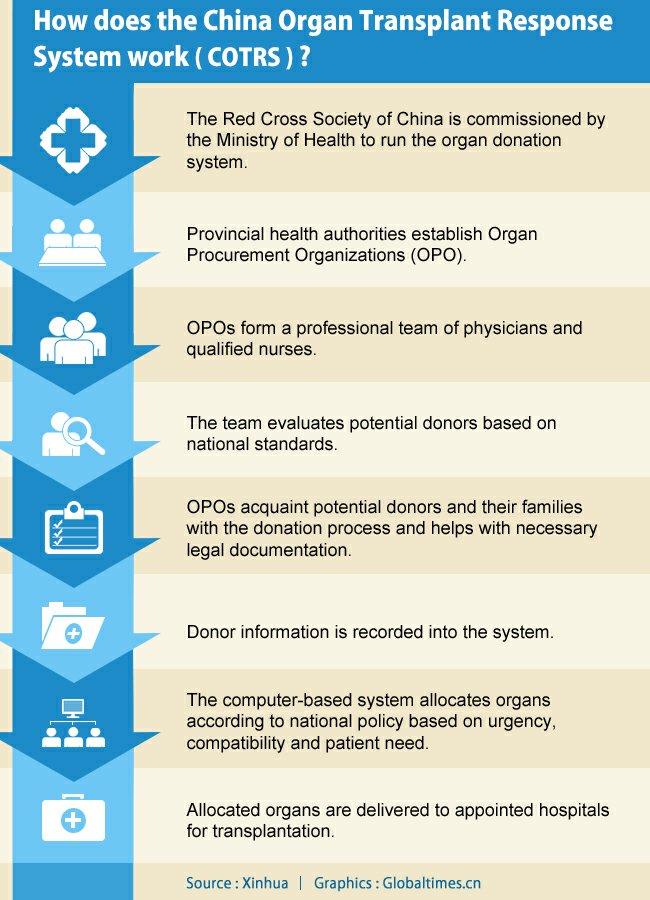HOME >>
Organ donor policy given new life
Source:Globaltimes.cn Published: 2013-9-28 14:30:00
| Editor's Note |
Though transplant networks have developed worldwide over the past 50 years, large differences remain among countries in terms of access, safety, quality and technology. However, China recently made great strides in organ donation through new policies and databases that enable 165 accredited hospitals nationwide to conduct organ donation and transplant surgery.
| Latest News |
Guangdong sets up organ center system
South China's Guangdong Province is establishing organ procurement organizations (OPO) and will publish the names of those organizations and their services by October.
Organ distribution system to be enforced
A computer-based system to distribute donated organs for transplant will be compulsorily brought into use at 165 accredited hospitals nationwide, according to a new regulation to take effect from September.
Organ donation program to operate in 165 hospitals
Hospitals that are qualified to carry out organ transplants but fail to develop a national organ donation program will have their transplant license revoked immediately in order to advance the program as promptly as possible.
| Transplantation |
Human organ transplantation began with a series of experimental studies at the beginning of the 20th century. Surgical transplantation of human organs from donors both living and deceased to sick and dying patients began after World War II.
Over the past 50 years, the transplantation of human organs, tissues and cells has become a worldwide practice which has extended, and greatly enhanced the quality of, hundreds of thousands of lives.
Continuous improvements in medical technology, particularly in relation to organ and tissue rejection, have led to an increase in the demand for organs and tissues, which has always exceeded supply despite substantial expansion in deceased organ donation as well as greater reliance on donation from living persons in recent years.
Source: World Health Organization
Different types of transplantation
| Human Cell and tissue transplantation | |
| Corneal graft | restore sight in corneal blindness |
| Haematopoietic stem cells | cure congenital or acquired diseases including some leukaemias |
| Human heart valve | often constitutes the best replacement situation and recipient patients do not require long term anti-coagulation therapy. |
| Kidney transplantation | is generally accepted as the best treatment both for quality of life and cost effectiveness and is by far the most frequently carried out transplantation globally.is generally accepted as the best treatment both for quality of life and cost effectiveness and is by far the most frequently carried out transplantation globally. |
| Hepatic transplantation | is the replacement of a diseased liver with a healthy liver from another person. |
| Xenotransplantation | |
| Animal into human, defined as living cells, tissues or organs of animal origin and human body fluids, cells, tissues or organs that have ex vivo with these living, xenogeneic materials, has the potential to constitute an alternative to material of human origin and bridge the shortfall in human material for transplantation. | |
Source: World Health Organization
| History Timeline |
Source: wellcomecollection.org
| Transplantation in China |
A computer-based system for the management and distribution of donated organs began nationwide on September 1, while a total of 165 hospitals across the country have been permitted to conduct human organ transplants.
Hightlights
Source: World Health Organization
Source: Global Times
Source: National Health and Family Planning Commission

| Challenges |
◆Commercial traffic
The shortage of available organs has not only prompted many countries to develop procedures and systems to increase supply, but has also stimulated commercial trafficking of human organs, particularly from living donors who are unrelated to recipients.
The evidence of such commerce, along with the related traffic in human beings, has become clearer in recent decades. Moreover, the growing ease of international communication and travel has led many patients to travel abroad to medical centers that advertise their ability to perform transplants and to supply donor organs for a single, inclusive charge.
Source: World Health Organization
◆Traditional attitude
Chinese people traditionally respect the intactness of a deceased body and believe it's unforgivable to interfere with it. In the past, a body would be buried in a tomb, but in the 1950s cremation was promoted by the central government. Although it took time for the policy to become widely accepted, cremated bodies are now considered by some to be intact as long as organs are not removed. After beloved relatives pass away, family members will pay a lot of money to put his or her ashes in a peaceful resting place.
Source: Global Times
| Voices on COTRS |
Wang Haibo, director of the China Organ Transplant Response System Research Center of the Ministry of Health
While we cannot deny the executed prisoner’s right to donate organs, an organ transplantation system relying on death-row prisoners’ organs is not ethical or sustainable. Now there is consensus among China’s transplant community that the new system will relinquish the reliance on organs from executed convicts.
Although it took decades to establish a sophisticated national organ donation system in western countries, I am optimistic that China can leapfrog to success in a relatively short period of time given the combination of governmental support and international experience.
Source: World Health Organization
Global Times
To solve the shortage, the health authorities need to make more efforts in public education. Through various channels, such as television programs, street advertising and college lectures, the authorities can gradually educate people about the whole procedure and let them understand the significance of organ donation: it saves lives.
Web editor: duliya@globaltimes.com.cn
Posted in: